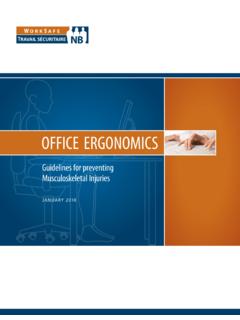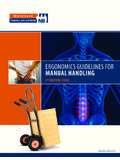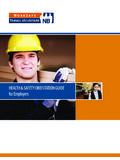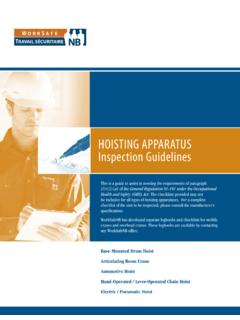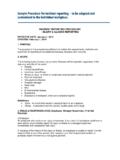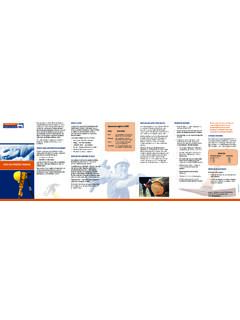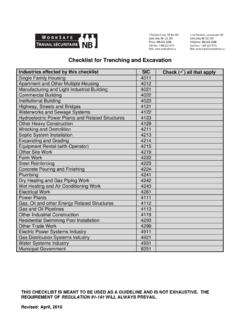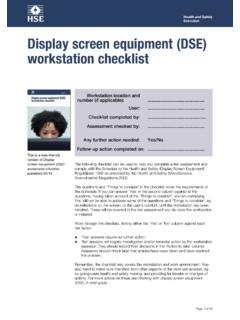Transcription of COMPUTER WORKSTATION ERGONOMICS - WorkSafeNB
1 COMPUTER WORKSTATION ERGONOMICSR evised December 2020 INTRODUCTION 4 The purpose of this guide Definitions POSTURE 5 CHAIRS 6 Armrests Back support Depth Height Seat tilt Width WORK SURFACE 7 INPUT DEVICES 8 Keyboard Mouse MONITOR 10 Distance Height and location Corrective lenses Lighting and glare Dual monitors LAPTOPS AND MOBILE DEVICES 11 Tablets and cell phonesADJUSTABLE WORKSTATIONS (SIT-STAND STATIONS) 11 OTHER ACCESSORIES 12 Palm rest/support Document holder Phone STRETCHES 13 COMPUTER WORKSTATION SET-UP CHECKLIST 14 TABLE OF CONTENTSINTRODUCTIONTHE PURPOSE OF THIS GUIDEThis guide will help determine if your COMPUTER WORKSTATION is a good fit for you.
2 It provides suggestions for basic tools to set up and maintain a healthy COMPUTER WORKSTATION . This guide is not designed to address specific injuries in that situation, a professional should be is recommended that a discomfort survey be completed by the user(s) both before any changes are made to a WORKSTATION , and after those changes are pre & post surveys will help determine the focus areas of an evaluation, as well as measure the effectiveness of any changes made in increasing user sample discomfort survey can be found on WorkSafeNB s guide includes: Definitions to help you get familiar with the terminology. Posture and equipment guidelines and standards. Stretches. COMPUTER WORKSTATION set-up The science of studying people at work and then designing tasks, jobs, information, tools, equipment, facilities and the working environment so people can be safe and healthy, effective, productive and comfortable.
3 ( ergonomic Design Guidelines, Auburn Engineering, Inc., 1998).Musculoskeletal Injury (MSI)An injury or disorder of the soft tissues, including tendons, ligaments, blood vessels and nerves, arising from exposure to risk factors such as awkward posture, repetitive motions, and forceful exertions. These injuries can be acute or cumulative. Signs and Symptoms of MSIs These can include tenderness, weakness, tingling, disturbed sleep, swelling, numbness, pain, unreasonable fatigue, and difficulty performing tasks or moving specific parts of the body. Stages of MSIs STAGE 1: Mild discomfort, present while working, but disappears when not working. Does not affect work or activities of daily living. STAGE 2: Pain is present while working and continues when not working. May be taking pain medication. Begins to affect work and activities of daily living.
4 STAGE 3: Pain is present all the time. Work is affected. May not be able to complete simple activities of daily rest (wrist rest)A soft surface designed to rest the palms. Often mistakenly used to rest the and positions used to increase range of motion (ROM).Warm-upActivities performed before stretching to warm the WorkSafeNBPOSTUREAt your COMPUTER WORKSTATION , optimal posture can be described as:This image depicts optimal sitting posture. Please note, however, that no posture is ideal indefinitely. You must change your posture and position frequently by alternating tasks (typing, writing, walking and standing ) as often as possible. This will ensure proper blood flow and reduce the risk of injury. Feet fully supported and flat on the floor. If this isn t possible, then the feet should be fully supported by a is the most important aspect when looking at WORKSTATION , work surfaces, input devices, personal habits and education, monitors and accessories can help or hinder in maintaining optimal posture, but they cannot cause optimal posture.
5 For example, having an adjustable chair does not guarantee, but merely facilitates, optimal posture. It is up to the user to identify their optimal posture, and how to make WORKSTATION adjustments to help maintain upright and over your shoulders. Eyes looking slightly downward without bending from the bent at 90 , forearms horizontal. Shoulders should be relaxed, but not in a neutral posture (straight).Back should be supported by the backrest of the chair that promotes the natural curve of the lower back. Thighs horizontal with a 90 120 angle at the andeducationWorksurfaceInputdevicesAcces soriesMonitorPOSTURECOMPUTER WORKSTATION ERGONOMICS 5 Knee heightLumbar supportDepth of seatCHAIRSWhen workstations cause discomfort, the first place people typically look is their chair. There are some basic guidelines to look for in a well-fitted office chair.
6 ARMRESTSA rmrests should be adjusted to elbow height. Too high, the shoulders will be shrugged; too low, the shoulders will be depressed. However, the armrests should not prevent the chair from being positioned close to the desk, nor restrict natural movements. If your armrests cannot be adjusted to allow for this, then consider removing or replacing them. Also, keep in mind that soft armrests will minimize contact stresses on your elbows. Gel wraps can be purchased to go over armrests that may be too hard. BACK SUPPORTWhen sitting, adjust the height of the backrest so the lumbar pad supports the natural curve of your lower back (lumbar curve). The tilt of the back support should allow you to sit with your upper body slightly reclined. The following sections provide information on how to adjust your chair and WorkSafeNBDEPTH When sitting, the seat pan (part of the chair you sit on) should allow you to use the back support without the front of the seat pressing against the back of your knees.
7 If the seat is too deep, try a back support or lumbar roll to reduce the size of the seat pan. Some chairs have adjustable seat standing, adjust the height of the chair so the highest point of the seat is just below your kneecap. This should allow your feet to rest firmly on the floor when seated. If you feel pressure near the back of the seat, raise your chair. If you feel pressure near the front of the seat, lower your chair. The goal is to evenly distribute your weight. SEAT TILTSeat tilt can be adjusted to improve your comfort. This will also affect your weight seat pan should be wide enough so it does not apply pressure to your thighs, but narrow enough to be able to reach the armrests when they are properly adjusted. WORK SURFACELike your chair, your work surface should fit you. Once you have adjusted your chair, you can determine the appropriate height for your work surface.
8 The top of your work surface should be at your elbow height. Make any necessary adjustments by raising or lowering your work surface. If your work surface cannot be raised or lowered to accommodate your elbow height, you can raise your chair and use a footrest. The footrest should be large enough for both feet. Please note that a footrest can restrict movement and make it more difficult for a user to adjust chair necessary, a keyboard tray can be used to bring the keyboard and mouse to elbow height. A keyboard tray should be stable, height adjustable, have room for both the keyboard and mouse on the same surface, and should not limit used frequently should be located within easy reach. Keeping infrequently used items out of reach will encourage you to get out of your chair for them - this will promote blood circulation and reduce overall discomfort. Usual workOccasional workNon-working areaCOMPUTER WORKSTATION ERGONOMICS 7 Awkwar d wrist postureCorrect wrist postureNeutral wrist postureAwkwar d wrist postureCorrect wrist postureNeutral wrist postureAwkwar d wrist postureCorrect wrist postureNeutral wrist postureAwkwar d wrist postureCorrect wrist postureNeutral wrist postureINPUT DEVICEST here are several different types of input devices.
9 The most popular and widely -used are the keyboard and mouse. When using a keyboard and mouse, your upper arms should be relaxed and by your sides, your elbows bent at a right angle (90 degrees) and your wrists are many types of keyboards designed to place the hands in a more neutral position to help prevent injuries. The effectiveness of alternative keyboards depends on the user and the type of work being mouse should be at the same surface/height as the keyboard and easy to reach. Users are encouraged to alternate mouse usage between the left and right hands (by changing hands you are using different muscles, thereby reducing the risk of injury). Users can go to the operating system control panel to adjust the button assignment so the primary button is the one closest to the keyboard. Your keyboard should lie flat or with a negative slope (tilted slightly away from you), not propped up on keyboard legs.
10 If a tilting keyboard tray is used, the edge of the keyboard closest to you should be at elbow height. Trial periods are recommended when introducing new devices. This will help to determine the suitability of the device as well as allow the user to become accustomed to wrist postureAwkward wrist postureNeutral wrist postureKeyboard with a negative slope8 WorkSafeNBTo further reduce the risk, limit mouse use and use keyboard shortcuts instead. Here are some examples of keyboard shortcuts that can be used in most popular software programs:BASIC FUNCTIONS(PC) (MAC)IT DOESAlt+Tab Command-TabNext programAlt+F4 Option-Command-EscClose programEDITING AND FORMATTING(PC) (MAC)IT DOESCtrl+B Command-BBold selected areaCtrl+I Command-IItalicize selected areaCtrl+U Command-UUnderline selected areaCtrl+Z Command-ZUndoCtrl+A Command-ASelect allCLIPBOARD RELATED COMMANDS(PC) (MAC)
